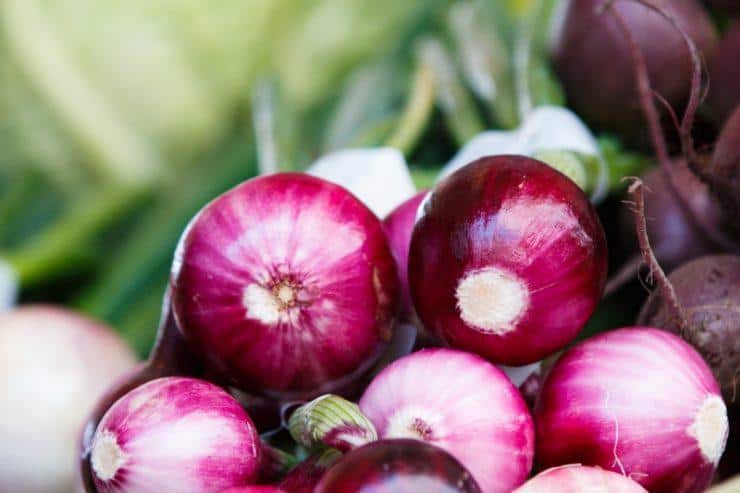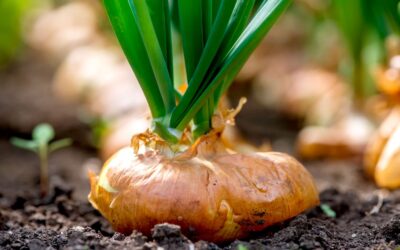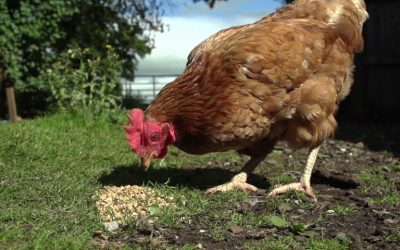Post-Harvest Handling and Storage for Onions

Onions are ready for harvest when the necks are reasonably dry and the tops have fallen over. As onions mature, their dry matter content and pungency increase, with a resulting increase in storage potential.
Harvest onions when the weather is dry; harvesting after a rainfall, or when the humidity is high increases susceptibility to post-harvest disease. At harvest, bulbs must be firm, with mature necks and scales, and must be a good size. Defective onions (i.e. sprouted, insect damaged, sunscalded, green, bruised) should be discarded.
For optimum storage quality, onions must be cured soon after harvest by placing them in a drying room at 20-30°C and 70% relative humidity for 12 to 24 h. Curing decreases the incidence of neck rot, reduces water loss during storage, prevents microbial infection, and is desirable for development of good scale color.
The optimum temperature for long-term storage of onions is 0°C with 65-70% relative humidity. To ensure a storage life of up to 8 months, onions must be promptly stored after curing. Exposure to light after curing will induce greening of the outer scales.
Pre-mature sprouting in onions reduces marketing potential. Preharvest application of a sprout suppressant, such as maleic hydrazide, retards sprouting and prolongs storage life. Different onion types have different storage potentials. The storage potential of onions follows the order: yellow>red>white>Spanish and sweet. Within each color group there are significant differences between cultivars in their storage potential.
Onions are susceptible to a number of physiological disorders during storage such as, watery scales, translucent scales and freezing injury. Symptoms of watery scales include a thick leathery skin with watery glassy scales below; freezing injury resembles watery scales and is characterized by soft water soaked scales. Translucent scales are characterized by a water-soaked translucent appearance. These physiological disorders often become entry points for fungal and bacterial rots. For control of these problems, effective curing and prompt storage are critical.
Storage Diseases
Onions are susceptible to Botrytis neck rot during storage. The disease is characterized by grey fungal growth, often watery in nature, at the neck area and on the outer scales. The infection usually spreads quickly through the whole onion. Bruising of onion bulbs during harvesting, storing under humid conditions, and exposing the inner tissues due to breakage of outer scales increase the incidence of Botrytis neck rot. Curing onions prior to storage will reduce the incidence of this disease.
Black mould, caused by Aspergillus niger, is characterized by black discoloration at the necks of onions. The black discoloration can sometimes be found on the outer scales. Bruised onions are more susceptible to this fungus. Black mould causes the tissues to become water soaked which often induces bacterial soft rot. Although low temperature storage delays growth of the fungus, exposure of infected onions to temperatures above 15°C, as occurs during marketing, will accelerate its growth.
Stored onions are also susceptible to blue mould, caused by Penicillium. Penicillium moulds induce watery soft rot of onion tissues and/or blue-green discoloration at the neck or other tissues. Minimizing mechanical damage and proper curing often reduces the incidence of this fungus.
Bacterial soft rots caused by Erwinia often occur during storage of onions. Onions infected by bacterial soft rots often appear healthy on the outside but when cut open some of the inner scales are brown, water-soaked and have a cooked appearance. A characteristic foul smell often occurs and the centre core of the onion often slips out when pressure is applied at the base of the onion. Bacterial rots caused by Pseudomonas infects outer scales and are characterized by yellow slime which produce a sour odour.
Control of fungal and bacterial rots of onions can be achieved by:
1. Pre-harvest application of a registered fungicide such as Rovral.
2. Harvesting at proper maturity
3. Minimizing bruising of bulbs
4. Discarding defective onions
5. Prompt and effective curing
6. Storing as quickly as possible

